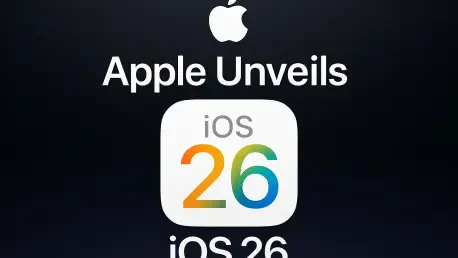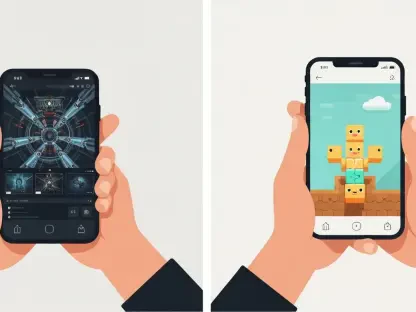In an era where smartphone innovation often feels incremental, Apple has managed to capture the imagination of tech enthusiasts with the announcement of iOS 26, a transformative update that promises to redefine the iPhone user experience. Set to roll out later this fall, this latest operating system introduces a bold visual overhaul paired with practical enhancements that could set a new standard for mobile interfaces. Beyond mere aesthetics, the update also brings a host of functional upgrades designed to streamline daily interactions. However, with progress comes the inevitable question of compatibility, as not all iPhone users will be able to join in on this evolution. This development reflects Apple’s ongoing commitment to pushing technological boundaries while maintaining a firm stance on modern hardware requirements. As anticipation builds, the focus shifts to what this means for millions of users worldwide, balancing excitement for cutting-edge features against the practicalities of device support.
Visual Revolution with Liquid Glass
The centerpiece of iOS 26 is undoubtedly the Liquid Glass design, heralded as Apple’s most significant visual update in years. This aesthetic shift draws inspiration from past bold designs like Windows Vista but refines it into a sophisticated, cohesive look that spans across Apple’s ecosystem. App icons have been reimagined with options for dark mode and transparency, creating a seamless blend with the background. Floating button designs add a sense of depth, making interactions feel more intuitive and fluid. This overhaul isn’t just about looks; it aims to unify the visual language across devices, ensuring a consistent experience whether on an iPhone or other Apple products. For users, this means a refreshing departure from familiar layouts, potentially rekindling a sense of discovery with every tap and swipe. The design philosophy appears to prioritize both form and function, setting a high bar for what a mobile interface can achieve in terms of elegance and usability.
Beyond the surface, the Liquid Glass design also integrates subtle animations and transitions that enhance user engagement without overwhelming the senses. These dynamic elements respond to touch and movement, offering a tactile illusion that makes the screen feel almost alive. Apple has clearly invested in ensuring that this visual transformation doesn’t compromise performance, optimizing the system to maintain smooth operation even on supported older devices. This balance is crucial, as it addresses potential concerns about battery life and responsiveness, areas where past visual updates sometimes faltered. Additionally, the redesign extends to system-wide elements like notifications and widgets, which now appear more integrated and less intrusive. For many, this could redefine how they interact with their iPhones, turning routine tasks into visually rewarding experiences. As this design rolls out, it will be fascinating to see how it influences user perceptions of what a premium mobile OS should look and feel like.
Functional Upgrades for Everyday Use
Alongside its striking visuals, iOS 26 introduces a suite of functional enhancements aimed at making daily tasks more efficient and connected. One standout feature is the revamped Phone app, which has been restructured for easier navigation through contacts, recent calls, and voicemails. This update addresses long-standing user frustrations with cluttered interfaces, offering a cleaner, more accessible layout. Another notable addition is Live Translate, a tool that enables real-time conversation translation during calls or text exchanges, breaking down language barriers with impressive accuracy. Additionally, a new Polls feature in group messages allows for quick decision-making, streamlining group coordination. These updates reflect a clear intent to enhance communication, a core function of any smartphone, and position iOS 26 as a tool for both personal and professional interactions in an increasingly globalized world.
Further enriching the user experience, these functional upgrades are designed to integrate seamlessly with the new visual framework of iOS 26. The Live Translate feature, for instance, not only performs its task but does so with elegant on-screen prompts that align with the Liquid Glass aesthetic. Similarly, the Polls feature in messaging apps appears as a natural extension of the redesigned interface, ensuring that new tools don’t feel tacked on but rather part of a holistic update. Apple has also focused on accessibility, embedding options within these features to cater to diverse user needs, such as customizable text sizes and voice feedback. This thoughtful approach suggests a deep understanding of how varied the iPhone user base is, spanning different ages, abilities, and preferences. As these features become available, they are likely to redefine expectations for what a mobile operating system can facilitate, pushing the boundaries of convenience and connectivity in meaningful ways.
Compatibility and User Considerations
A critical aspect of iOS 26’s rollout is its compatibility framework, which determines which iPhone models can embrace this update. Devices released from 2019 onward, starting with the iPhone 11 series up to the anticipated iPhone 16 series, along with the iPhone SE (second generation and later), are eligible for the upgrade. However, models from 2018, including the iPhone XR, XS, and XS Max, will not support this new OS, continuing Apple’s trend of phasing out older hardware to ensure optimal performance. This cutoff, while expected, may disappoint some users still relying on these devices, as they miss out on both aesthetic and functional advancements. It underscores a broader strategy of prioritizing system efficiency over universal access, a decision that shapes the upgrade cycle for millions of users globally and prompts important conversations about device longevity in the tech landscape.
For those with incompatible devices, the implications extend beyond missing out on new features. Without access to iOS 26, older iPhones will no longer receive critical security updates, potentially exposing them to malware and other digital threats. Furthermore, as apps increasingly require newer OS versions, functionality could be compromised, leaving users with a diminished experience over time. While continuing to use an older device remains an option, the risks of outdated software highlight the importance of considering an upgrade. Apple’s stance on compatibility serves as a reminder that technological progress often comes with a hardware cost, pushing users to weigh the benefits of new features against the investment in newer models. This dynamic shapes not just individual choices but also broader trends in consumer behavior, as the balance between innovation and accessibility remains a pivotal discussion in the smartphone industry.
Looking Ahead to the Rollout
Reflecting on the unveiling of iOS 26, it becomes clear that Apple has set a bold course with a transformative visual identity through the Liquid Glass design and practical tools like Live Translate and an updated Phone app. The announcement, timed with the traditional mid-September release window following the iPhone 17 event, generated significant buzz among tech circles. A public beta made available earlier allowed eager users to glimpse these changes firsthand, providing valuable feedback before the final launch. Compatibility constraints, particularly the exclusion of 2018 models, sparked discussions about the pace of obsolescence in tech, yet the supported range from 2019 devices onward offered a broad base of users the chance to experience this update. This rollout marks a pivotal moment in Apple’s ongoing narrative of blending cutting-edge design with user-focused functionality.
Moving forward, users are encouraged to assess their device status to ensure readiness for iOS 26, weighing the benefits of upgrading if their current iPhone falls outside the compatibility range. Exploring the public beta could provide deeper insights for those curious about specific features, while keeping an eye on official announcements will confirm the exact release date. For developers and app creators, adapting to the new design language and features presents an opportunity to enhance user engagement through innovative updates. Meanwhile, the industry watches closely to see how this update influences design trends and compatibility standards across other platforms. As Apple continues to refine its ecosystem, the lessons from this launch—balancing innovation with accessibility—will likely shape future updates, offering a blueprint for navigating the ever-evolving intersection of technology and user needs.









